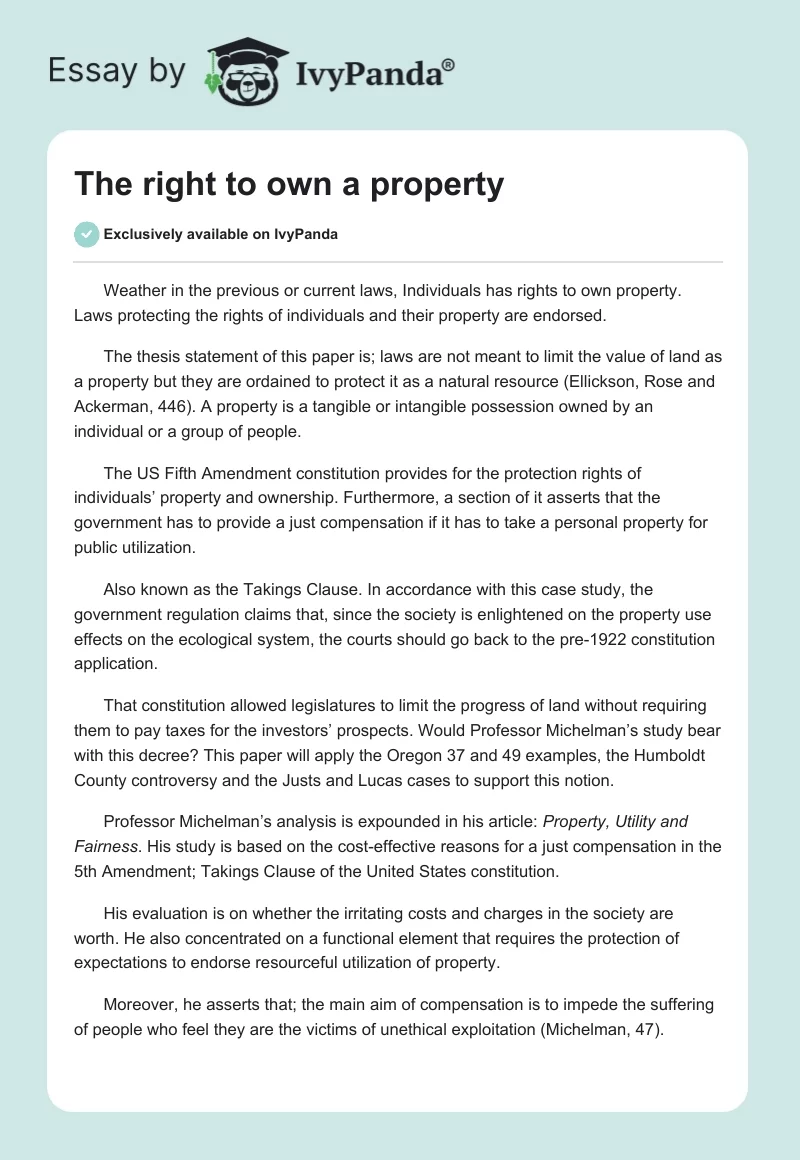Weather in the previous or current laws, Individuals has rights to own property. Laws protecting the rights of individuals and their property are endorsed.
The thesis statement of this paper is; laws are not meant to limit the value of land as a property but they are ordained to protect it as a natural resource (Ellickson, Rose and Ackerman, 446). A property is a tangible or intangible possession owned by an individual or a group of people.
The US Fifth Amendment constitution provides for the protection rights of individuals’ property and ownership. Furthermore, a section of it asserts that the government has to provide a just compensation if it has to take a personal property for public utilization.
Also known as the Takings Clause. In accordance with this case study, the government regulation claims that, since the society is enlightened on the property use effects on the ecological system, the courts should go back to the pre-1922 constitution application.
That constitution allowed legislatures to limit the progress of land without requiring them to pay taxes for the investors’ prospects. Would Professor Michelman’s study bear with this decree? This paper will apply the Oregon 37 and 49 examples, the Humboldt County controversy and the Justs and Lucas cases to support this notion.
Professor Michelman’s analysis is expounded in his article: Property, Utility and Fairness. His study is based on the cost-effective reasons for a just compensation in the 5th Amendment; Takings Clause of the United States constitution.
His evaluation is on whether the irritating costs and charges in the society are worth. He also concentrated on a functional element that requires the protection of expectations to endorse resourceful utilization of property.
Moreover, he asserts that; the main aim of compensation is to impede the suffering of people who feel they are the victims of unethical exploitation (Michelman, 47).
On the other hand, the Oregon measure 37 was accepted by the people in 2004. This allowed land owners to develop their land in accordance with the agreement during purchase. However, the Oregon measure 49 was an advancement of Oregon measure 37; it brought back the development rights by eradicating the sub divisions and the commercial developments.
The difference between the Oregon measure 37 and 49 is that the 37 measure plaintiffs settled for a process that permitted them to put up subdivisions unlike in 49 which allows them to erect one to three homes.
At the same time, measure 49 allows individuals to build a couple of family homes in their land if they wished to. Both measures 37 and 49 generate a “just compensation” best for Oregon land owners if public entities endorse a land utility rule that limits the use of personal property (Hogan, 152).
In relation to the question, Professor Michelman’s theory complies with the two Oregon measures. This is because they both deal with just compensations of the property owners (Freyfogle, 243).
According to the Humboldt County Farm Bureau Board of Directors’ policies on land utilization, individuals are supposed to preserve the farming land, produce high quality farm and animal products and safeguard the rural life of the Humboldt County.
To achieve these goals, they established ordinances to guide them. However the controversy sets in when the state claims that four of their ordinances were conflicting with the government statues.
In relation to Professor Michelman’s study, the Humboldt County controversy case does not put into consideration, the property owner expectations and costs. In addition, there is nothing mentioned like compensation, hence contradicting with the professor’s analysis.
In Just and wife, versus Marinette County’ case, the land the Justs purchased was designated as a bog on the US geographical map. They were therefore supposed to secure a permit of twenty dollars or pay a penalty of twenty to two hundreds dollars depending on his violations.
Thus, what professor Michelman termed as nuisance costs. The Justs later refilled the swamp because it had depreciated in value. This was against the law because a wet land is a public property.
It’s a discrepancy for the public to end desecration of natural resources and it’s therefore achieved by the use of the police power. This case is not successful in accomplishing professor Michelman’s analysis because it does not have a just compensation thesis.
In the case of Lucas v. South Carolina coastal council, Lucas had procured two residential housing spaces in South Carolina barricade Island. He intended to construct sole family residence in 1986 and in 1988.
Later, the Beachfront Management Act was created thus banning him from building any eternal livable houses on his territory. This forced him to sue the respondent claiming that, even if the Act was lawful, it deprived him the beneficial use of his land (Ellickson, Rose and Ackerman, 446).This was really against professor Michelman’s views on the takings clause. He therefore recommended the fifth and fourteenth amendments which uphold the just compensation.
In conclusion, there is a relationship between professor Michelman’s analysis and the pre-1922 property laws. They both emphasizes on just compensation also found in the taking clause of the constitution.
In addition, they put in mind the land owners expectations and costs. However individuals owning marginalized land should expect the use of their property limited because of the time to time enactment of new laws (Fruehward, 121).
Works Cited
Ellickson, Robert C, Carol M Rose and Bruce A Ackerman. Perspectives on Property Law. New York: Aspen Publishers, 2002. Print.
Freyfogle, Eric. On Private Property: Finding Common Ground on the Ownership of Land. New York: Beacon Press, 2009. Print.
Fruehward, Edwin M. A Biological Basis of Rights. New York: California press, 2010. Print.
Hogan, Dave F. Voter guide thick with Measure 49 arguements. Oregon: Oregonian press, 2007. Print.
Michelman, Frank I. “Comments on the Ethical Foundations of “Just Compensation”.” Property, Utility and Fairness (1967): 46-50. Print.


